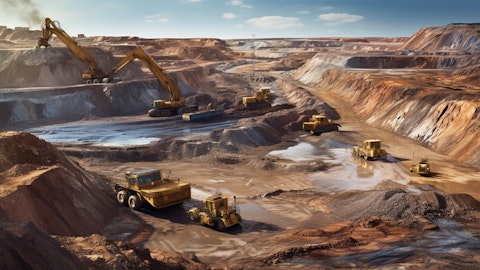North American Construction Group Ltd. (NYSE:NOA) Q4 2023 Earnings Call Transcript March 14, 2024
North American Construction Group Ltd. isn’t one of the 30 most popular stocks among hedge funds at the end of the third quarter (see the details here).
Operator: Good morning, ladies and gentlemen. Welcome to the North American Construction Group Conference Call regarding the Fourth Quarter Ended December 31, 2023. At this time, all participants are in a listen-only mode. Following management’s prepared remarks, there will be an opportunity for analysts, shareholders and bondholders to ask questions. The media may monitor this call in listen-only mode. They are free to quote any member of management but they are asked not to quote remarks from any other participant without that participant’s permission. The company wishes to confirm that today’s comments contain forward-looking information and that actual results could differ materially from a conclusion, forecast or projection contained in that forward-looking information.
Certain material factors or assumptions were applied in drawing conclusions or in making forecasts or projections that are reflected in the forward-looking information. Additional information about those material factors is contained in the company’s most recent Management’s Discussion & Analysis which is available on SEDAR and EDGAR, as well as the company’s website at nacg.ca. I will now turn the conference over to Joe Lambert, President and CEO.
Joe Lambert: Thanks, Joanna. Good morning, everyone and thanks for joining our call today. I’m going to start with a few slides showing our 2023 operational performance before handing it over to Jason for the Q4 financial overview and then I’ll conclude with our 2024 operational priorities, our bid pipeline, outlook for 2024 and finish up with our capital allocation plan before taking your questions. On Slide 3, our record Q4 safety performance contributed positively in achieving a trailing 12-month total recordable rate of 0.29 which is the second best annual rate in company history and remains well below our industry-leading target frequency of 0.5. We will continue to focus our efforts on further advancing our training, systems and processes to identify and eliminate hazards and health risks in our business.
On Slide 4, we highlight some of the major achievements of 2023. The MacKellar acquisition was the obvious major accomplishment during the year. And with the strength of the Australian resource industry and the strength of our own team down there, I’m confident our Australian businesses will be highlighted in our annual accomplishments for many years to come. Our Fargo-Moorhead flood diversion project completed its ramp up for its first full year of construction in 2023 and we enter our largest year of earthworks construction in 2024, with confidence in our productivity and our overall project plan. Our telematics system continues to provide more detailed and meaningful operations and maintenance data every day and the 95% reliability is an impressive achievement.
Also impressive is the $5.3 million of maintenance savings achieved in 2023 and systems operating costs more than 30% below budget. We are targeting to have this same or similar telematics system tested in Australia in 2024 with full rollout expected to commence in 2025. And last but not least, we successfully completed our Ontario gold mine construction project through our NAN JV partnership and have several active bids in the Ontario and Quebec regions. Slide 5 captures all of our financial highlights for the year and the 17% to 28% year-on-year increases include only a Q4 of MacKellar contributions and a negative contribution from Nuna. I’m already eager to see what this slide looks like this time next year with a full year of MacKellar contributions and a Nuna return to operational excellence.
On Slide 6, you will see our EBITDA and EPS results for the last 5 years which I hope you agree is an impressive trend and one that we expect to continue. When people try to tell me how risky and volatile our resource-based business can be, I’d like to point them to graphs like these and remind them this is what was achieved with a pandemic in the middle. On Slide 7, we have updated our calculation methodology and added our Australian fleet to our utilization graphs. One of the inherent benefits in the Australian market is the 5% to 15% upside utilization potential when demand is strong. We remain on track and confident in our ability to hit our Canadian target range of over 75% by the end of this year and we’ll also be looking to similarly increase our Australian fleet to over 85% during this same period.
With that, I’ll hand it over to Jason for the Q4 financials.
Jason Veenstra: Thanks, Joe and good morning, everyone. To start, I will provide brief context regarding the MacKellar transaction which closed effective October 1, 2023. As disclosed in our financial statements, the overall purchase price for the MacKellar Group was $383 million which included $394 million of PP&E which in our case, is the heavy equipment fleet. This overall purchase price included $14 million of cash which MacKellar had in their bank accounts on close. And when factoring $35 million of equipment we purchased after October 1, the all-in cost was $405 million and consistent with expectations. EBITDA generation to-date is slightly higher than initial expectation and confirms the less than 2.75 multiple we disclosed last July.
The transaction and gross spending were fully funded with debt, with approximately 70% of this debt being senior secured and 30% being vendor provided. At the time of announcement in July, we had targeted net debt leverage of 1.8x by the end of 2023 and are very happy to have slightly beat that target. We’ve had an excellent first few months with MacKellar and are looking forward to further integration and reporting progress in the months to come. Our teams are in daily dialogue between Canada and their Australian counterparts with weekly and monthly processes starting to become routine. Moving to the financials and some brief commentary. On Slide 9, the headline EBITDA number that exceeded $100 million for the first time in our company’s history was driven by a full quarter of MacKellar results.
It exceeds our previous record by about 20% and exceeded Q3 by 70%. All businesses — all business units contributed to this result with the exception of Nuna which we will discuss later and is a metric, among many, that our diversification efforts make us stronger and more consistent. Moving to Slide 10 and our combined revenue and gross profit. As we will have now for 4 quarters, MacKellar will provide step changes in quarter-over-quarter variances. On a total combined basis, we are up $83 million quarter-over-quarter. MacKellar and DGI which we combine as Australia in our results, were up $128 million which could have been higher if the rainfall in November and December had been less severe. This rainfall impact can be seen in Australia’s equipment utilization which almost hit 85% in October but fell to the mid-70%s in November and December.
This positive variance was offset primarily by lower equipment utilization in the oil sands region. Our share of revenue generated by joint ventures and affiliates was a net $10 million lower than Q4 2022. The Fargo-Moorhead project had an excellent operational quarter and achieved the progress metrics and milestones required of the project’s schedule. In addition, we had positive contributions from the continued growth of top line revenue from rebuilt ultra-class haul trucks and excavators owned by our joint venture with the Mikisew. More than offsetting these positives, the completion of the construction project at the gold mine in Northern Ontario led to lower quarter-over-quarter revenues within the Nuna Group of Companies. Combined gross profit margin was 18.4%, despite the challenges experienced by Nuna and again, reflects the strength of a diversified business.

As both Joe and I have alluded to, losses at 3 specific mining projects within the Nuna Group of Companies had a direct impact on margins. Joe will expand in his comments for Nuna moving forward but from a financial perspective, excluding these project losses, would have yielded an overall margin of approximately 20%, given the impact of $7.5 million. Gross profit margins benefited both from the operations in Australia, higher than 20% in the quarter which is normal course and from ML Northern whose fleet lowers our internal cost as well as generate strong margins from services provided to external customers. Moving to Slide 11. Record adjusted EBITDA was consistent and reflective of the revenue commentary. The 25% margin reflects an effective operating quarter with a positive trend from the Q3 margin of 22%, indicative of where we see our business operating at.
Included in EBITDA is direct and general and administrative expenses which, when excluding one-time acquisition costs, were $12.8 million in the quarter, equivalent to 3.9% of revenue and remained under the 4% threshold we’ve set for ourselves. MacKellar runs a similar G&A profile and is not expected to change our G&A burden as a percentage of revenue. Going from EBITDA to EBIT, we expensed depreciation equivalent to 11.8% of combined revenue which reflected the depreciation rate of our entire business, including the equipment fleet at the Fargo-Moorhead project. When looking at just the wholly owned entities and our heavy equipment in Canada and Australia, the depreciation percentage for the quarter was 12.8% of revenue and reflected the addition of the Australian fleet and an overall efficient productive use of equipment in the quarter.
Adjusted earnings per share for the quarter of $0.87 was $0.23 down from Q4 2022 as the impacts of higher interest are factored in with EPS, with the project losses at Nuna being particularly impactful to EPS at approximately $0.20. The average interest rate for Q4 was over 8.5% as were up from the Q3 rate of 7%. This effective interest rate is the highest we’ve paid in a long time, is a compelling indicator for us to look to pay down debt in 2024. Moving to Slide 12, I’ll briefly summarize our cash flow. Net cash provided by operations of $161 million was generated by the business, reflecting EBITDA performance and working capital collection, net of cash interest paid. Free cash flow was $111 million as sustaining capital of $41 million was invested in the fleets in both Canada and Australia.
Moving to Slide 13, our PP&E of $1.1 billion is up $450 million from September 30 on the $430 million worth of MacKellar assets we purchased. Net debt levels ended the year at $721 million, an increase of $326 million in the quarter, as the $405 million of net debt incurred related to MacKellar was offset by free cash flow generation. Net debt leverage and senior secured debt leverage ended at 1.7x and 1.4x, respectively and are considered reasonable levels 3 months after a transformative debt-funded acquisition. And with that, I’ll pass the call back to Joe.
Joe Lambert: Thanks, Jason. Looking at Slide 15, this slide summarizes our priorities for the year. I’ll speak to the MacKellar integration and growth in detail on the next slide, so I’ll jump to the second point. This area of focus is our ongoing efforts to win strategic projects for our business. As we look to sustain and grow our infrastructure business, we’ll need to win infrastructure work as our Fargo-Moorhead flood diversion project reaches completion. Although this project is several years away from completion, the tender qualification and the RFP process can take 1 to 3 years, depending on the size and complexity of the projects. As such and with a strong fit potential U.S. infrastructure project in the bid pipeline, we believe this year’s priority should be to qualify as part of a team on one major infrastructure project.
The second part of this priority is to win a meaningful project that uses our smaller mining assets that are currently underutilized in our oil sands business. We have several active tenders in both Canada and Australia that would utilize these smaller assets and we expect to win one of these projects this year. Item 3 prioritizes continued expansion of our operational and maintenance expertise. We will prioritize new technologies such as our telematics system and continuing to in-house and vertically integrate our maintenance services and supply, including a near-term focus on identifying and sharing best practices between our Canadian and Australian businesses. We believe this prioritization and focus will continue to lower cost and improve equipment utilization, resulting in an increased competitiveness and likelihood in winning the tenders mentioned in the previous item 2.
The final area, prioritizing returning Nuna back to operational excellence and setting it up for growth and consistent performance. This work commenced earlier this year and I am confident in the changes made that Nuna will be back on its feet in time for their big summer projects and growing off a much stronger and stable foundation before the end of the year. Slide 16 shows some key milestones in our MacKellar integration plans, much of which I have discussed previously. Two points I would like to make are as follows: One, the transition team headed by our COO, Barry Palmer, is now resident in Australia and the integration has progressed smoothly and on plan. The second point which has been a pleasant surprise, is that the Australian marketplace has shown to be even better than originally contemplated.
As an example and as you would have recently seen in our press release last week, we were awarded a 5-year $500 million contract extension at a major metallurgical coal mine in Queensland. That contract extension was achieved through direct discussion with the customers and awarded 15 months before the original term expiry date. These alliance-type contracts with long-term commitments and early negotiated renewals show real strength in both the commodity markets and the client relationships. When you combine these market strengths with the higher fleet potential utilization in Australia, it’s easy to see the potential to improve returns on not just our underutilized smaller-sized assets but also increase the longer-term returns and internal competition for even our larger mining assets.
There is meaningful time and cost to ship our big assets halfway around the world but the opportunity to optimize return on our assets in lower-risk, longer-term contracts will be compelling and should provide a healthy internal competition for assets. Slide 17 illustrates a strong bid pipeline with the addition of Australian tenders and continued interest from long-term non-oil sands contract tenders. Although we truly believe our oil sands demand will remain strong for many years to come, we also see those big blue diversified dots and continued strong heavy equipment demand in Australia as opportunities to further diversify and reduce consolidation risk. On Slide 18, our pro forma backlog sits at $3.3 billion with the award of the Queensland major metallurgical coal mine and the award of the regional oil sands tender, offset by our normal quarterly drawdown from executed work.
The $3.3 billion backlog is the highest in company history and provides improved confidence and predictability in our business, especially in our Australian business. On Slide 19, we have provided our updated outlook for 2024. The outlook is mostly unchanged except for some timing-based reclassification of sustaining capital to growth and some growth capital additions supporting recently announced project awards. Lastly, on Slide 20. Capital allocation is always a focus for me and our projected free cash flow range of $160 million to $185 million gives us flexibility in that regard. Deleveraging presents an attractive opportunity at current interest rate levels and is our default choice. However, should share price drop to where we believe the risk-weighted return is higher, we have an established history in engaging in share repurchases where we see value in that for our shareholders.
The MacKellar integration is a focus for 2024 but we continue seeking growth opportunities, whether organically or through acquisition, that likewise generate superior risk-weighted returns and accretion. Any and all options compete for our capital allocation and this is something we analyze continually in seeking to always be opportunistic in directing our cash flow in a way that maximizes value. With that, I’ll open up for any questions you may have.
See also 10 Best Alternatives to Amazon Echo and Alexa and 11 Stocks Insiders are Buying Now.
Q&A Session
Follow North American Energy Partners Inc
Follow North American Energy Partners Inc
Operator: [Operator Instructions] First question comes from Yuri Lynk at Canaccord.
Yuri Lynk: Let’s talk about Nuna a little bit. It sounds like you’re expecting the issues that you encountered in the fourth quarter to be contained to the fourth quarter. But can you just elaborate on that, like when do these 3 projects wrap-up? And do you expect any spillover into Q1, Q2?
Joe Lambert: No, I think that’s an accurate assessment, Yuri. These projects are predominantly complete. There’s a little bit of tail end work on 1 or 2 of them. I don’t expect — we’ve put new leadership in place. The issues we saw were really around risk management, predominantly in dealing with junior miner clients, changed management and contract administration. These are things that are in our wheelhouse. We were blessed to have some strong bench strength here where we were able to put guys in place that had confidence in, in running those systems and processes going forward. So, I’m very — and this is the slow time of the year for Nuna. Nuna really picks up in Q2 and Q3 with their summer work, predominantly up north. And so, I think the timing and the moves we’ve made, we’ll put it in the past very quickly and I fully expect that our summer and a kick-off of our summer works will go as planned.
Yuri Lynk: Okay. You’re also — in your shareholder letter, you talked about the seasonal earnings pattern pro forma the MacKellar acquisition. Is 20% of EBITDA in the first quarter, is that going to be typical going forward? It looks a little bit low to me. Just wondering if that’s the — if there is anything else than that?
Joe Lambert: Yes. Again, I think you’re accurate there, Yuri, that we’ve got a little bit of an unusual year this year. I think we will be more consistent between quarters. But this particular year, like I just said, Nuna’s big quarters are Q2 and Q3. Same in Australia. So, Australian cyclone season is in the summer which is our winter. So they’re usually impacted operationally more in Q4 and Q1. And then, with our biggest construction year at Fargo, the summer is also the biggest part of that Fargo job. So, even though we had a good-sized construction year in 2023, it’s even bigger in Fargo this year and there’s more infrastructure construction, like bridges and roadwork that occurred during Q2 and Q3, whereas our previous earthworks is more year-round.
And then, we’ve just had a bit of a slower winter this year in oil sands even and we’re shuffling around some equipment in Q1. So, it is going to be more consistent between quarters but the lower Q1 this year is, I believe, a one-off.
Yuri Lynk: Okay. And just a follow-up to that one. I mean which quarter is going to be the largest? Q3?
Joe Lambert: I think so going forward. But we’re going to have projects that come and go too, Yuri, that depending on when they end. I think we’re going to be within 1 or 2 points between quarters going forward. But obviously, if there’s a new project start or stop in any one quarter, it can distort a year. But generally, I would say it’s going to be very consistent.
Operator: Next question comes from Maxim Sytchev at National Bank Financial.
Maxim Sytchev: Joe, I was wondering, if you don’t mind, please, expanding a little bit on the comments you made in your shareholder letter talking about some of the oil sands work right now transition to maintain rental fleet. And kind of similar, what you are seeing in Australia. Yes, do you mind providing a bit of more color on that?
Joe Lambert: Yes. I think we’ve provided — in the regional tender, we’ve provided pricing for unit rate work and we also provided pricing for maintained rental equipment and operated and maintained rental equipment. Historically, the unit rate work was what was awarded. And this year, about half of our big trucks are being rented or maintained rentals with operators versus the unit rate work. And it’s just the client believes that they have some excess assets in some categories, so they’d rather rent piecemeal versus unit rate and it’s believed that by doing this, I believe — they believe they’re lowering their cost and we have to respect that and hopefully it is. And we’re very happy to do it. It’s very similar to what’s being done in Australia.
Certainly, lowers their operating risk. You do take a bit of a hit on the top line but it’s not a huge difference. And this is just a contracting philosophy whereby the clients are trying to be more efficient with their own assets to lower their costs and we’re happy to participate in that.
Maxim Sytchev: Okay. But I guess, yes, structurally, I mean, is — how should we think about this? Is it sort of more visibility but better sort of ROIC on the assets from your perspective? Or how should — where you think that it doesn’t really make a huge amount of financial difference to you at NOA level?
Joe Lambert: I think the biggest difference is in the risk. When you’re — in unit rate work you wear a lot more risk of productivity and that could be in weather-related stuff like that. So, I guess the downside risk, I would say, is much lower. But I would agree that the visibility — the visibility is less so more because of the contract structure with the 3 years, with only the 1-year commitments more so than I think this change of philosophy a bit on the unit rate work.
Maxim Sytchev: Okay, understood. And then, another comment talking about sort of the TAM in Australia being dramatically larger than Canada for your type of work. Do you mind maybe expanding a little bit in terms of how you came up with that number? And at what point that could be potentially realized? I mean, I presume it’s a long-term, obviously, opportunity but maybe if you can provide any brackets, that would be helpful for us.
Joe Lambert: Are you referring to the 10x market item there, Max?
Maxim Sytchev: Yes.



